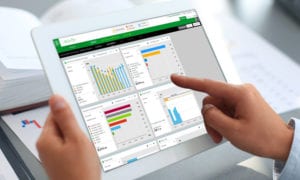In this post, we will look at how power analytics enable remote services that can help facility teams increase power resilience. This is the fifth post in my series on the benefits of power analytics in the ‘New Electric World’. In my last post we looked at how ‘digital twins’ can enable more effective power management applications, from diagnostics and simulation to prediction and prescription.

The Need for Remote Services in Power Analytics
The current pandemic has exposed the challenges of remotely managing sites. During the lockdown, many facility teams had limited access to properties. As businesses reopen, new policies may limit the time maintenance personnel can spend on site. At the same time, many organizations have to do more with less, due to the loss of their experts through retirement and staffing reductions. This makes it more difficult to monitor electrical infrastructure and respond when issues arise.
As noted in my previous posts, digitization of electrical networks provides facility teams with new IOT-based architectures that can address these challenges. Sensors automatically send ‘big data’ to the edge and the cloud where power analytics applications can deliver insights and recommendations directly to the team.
Cloud-based analytics can also enable remote services. Remote service teams complement and enhance the knowledge of the local facility team, ensuring that no risk or opportunity is missed to improve safety and resilience.
The next sections introduce three common types of remote services and describe how they can be improved with power analytics.
1. Remote Monitoring Services
Remote monitoring services ensure that electrical distribution networks and associated control systems are running smoothly. Today, remote service bureaus monitor large fleets of networks and alert onsite teams of issues, or directly take corrective actions when required.
A common problem with remote monitoring is making sense of all the data coming back from the many sites being monitored. How can someone respond to potentially hundreds of alerts in any given day? Analytic algorithms help by learning what is normal for a given site and alerting the service provider only when variables exceed the nominal operating ranges. There is no need to manually configure alarm thresholds for every monitored point. This dramatically increases the number of sites that can be efficiently monitored by a service engineer.
Combining robotics and power analytics can take remote services one step further. Today, air- and land-based robots can be used for monitoring and patrol of a site when stationary sensors are not possible. Until recently, due to limited on-board processing power, an onsite person was typically required to operate the robot and interpret the results in real-time.
Today and increasingly in the future, with improvements in battery technology, telemetry (5G), analytics, and remote services, we anticipate that robots will autonomously navigate and identify anomalies. Depending on what it senses, a robot will automatically investigate an area at a level of detail that a human may have missed. In this scenario, remote monitoring services scale from operating a single robot to supervising a fleet of robots.
2. Remote Maintenance Services
If an engineer is onsite for maintenance work, remote service providers can use power analytics to add value in several ways. First, while accessing the monitoring system, the remote expert shares insights in real-time with the onsite technician, through phone, text, or shared images.
Second, if we add augmented reality capabilities, the onsite engineer and the remote expert can collaborate in a shared virtual space. While remotely viewing the asset and its status, the expert will tell the onsite engineer the next steps or procedures to follow.
Advanced analytics will also enable a service expert to simulate an action remotely before recommending it to the onsite person. They can also continuously monitor all environmental conditions if that person is in a hazardous area or coordinate activities that require multiple onsite engineers.
In the future, we can imagine maintenance robots equipped with actuators, allowing them to operate in unsafe environments where a human is required now. For example, a robot might rack out and replace a breaker, or take an oil sample from a transformer for testing. Initially supported by a remote expert, the robot may eventually be able to perform autonomously.
3. Remote Performance Optimization Services
With the rich data collected by a remote monitoring service, service bureaus can apply analytics to offer performance optimization services. For example:
- Audit and upgrade an alarm management system to reduce operator fatigue
- Detect and prioritize power quality issues for resolution
- Analyze how to improve a communications network to reduce bottlenecks
- Determine the adjustments required to improve breaker coordination when a new industrial process is added
In all cases, a clear ROI of power analytics can be established due to the ability to represent the full business impacts and model the financial investment and returns.
Learn About Power Analytics, EcoStruxure, and Much More
The IoT-enabled, future-proof EcoStruxure™ Power architecture from Schneider Electric supports digitized power distribution, enabling enhanced connectivity, real-time operations, and smart power analytics. EcoStruxure Power Advisor is a proactive, analytics-based service for your power management system, delivering optimized energy performance, power reliability, and resilience.



